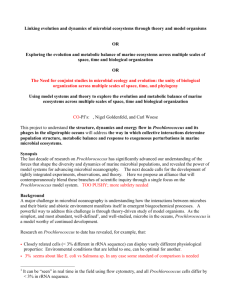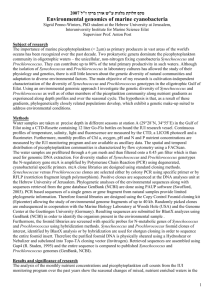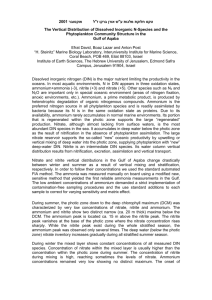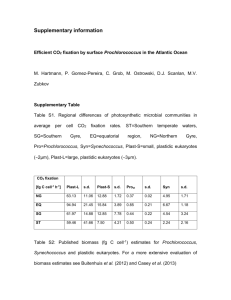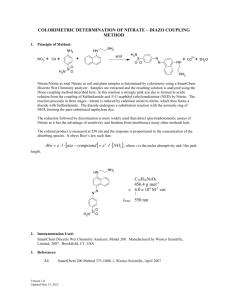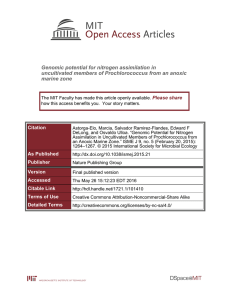Widespread metabolic potential for nitrite and nitrate assimilation among Prochlorococcus ecotypes
advertisement
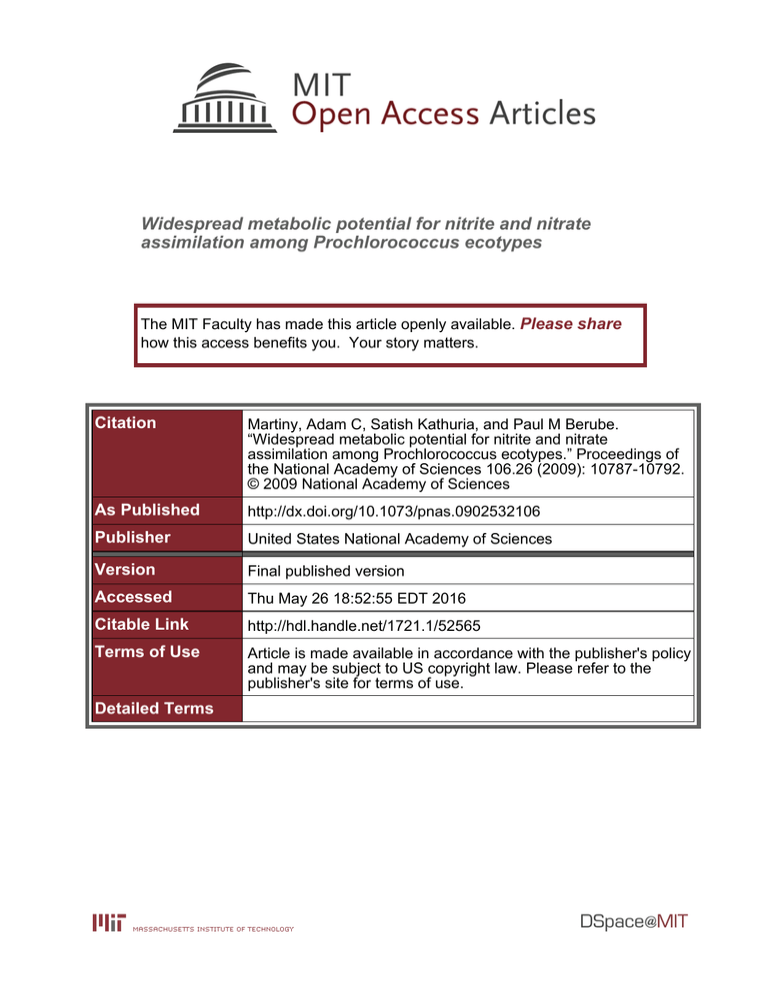
Widespread metabolic potential for nitrite and nitrate assimilation among Prochlorococcus ecotypes The MIT Faculty has made this article openly available. Please share how this access benefits you. Your story matters. Citation Martiny, Adam C, Satish Kathuria, and Paul M Berube. “Widespread metabolic potential for nitrite and nitrate assimilation among Prochlorococcus ecotypes.” Proceedings of the National Academy of Sciences 106.26 (2009): 10787-10792. © 2009 National Academy of Sciences As Published http://dx.doi.org/10.1073/pnas.0902532106 Publisher United States National Academy of Sciences Version Final published version Accessed Thu May 26 18:52:55 EDT 2016 Citable Link http://hdl.handle.net/1721.1/52565 Terms of Use Article is made available in accordance with the publisher's policy and may be subject to US copyright law. Please refer to the publisher's site for terms of use. Detailed Terms SEE COMMENTARY Widespread metabolic potential for nitrite and nitrate assimilation among Prochlorococcus ecotypes Adam C. Martinya,b,1, Satish Kathuriaa, and Paul M. Berubec Departments of aEarth System Science and bEcology and Evolutionary Biology, University of California, Irvine, CA 92697; and cDepartment of Civil and Environmental Engineering, Massachusetts Institute of Technology, Cambridge, MA 02139 The marine cyanobacterium Prochlorococcus is the most abundant photosynthetic organism in oligotrophic regions of the oceans. The inability to assimilate nitrate is considered an important factor underlying the distribution of Prochlorococcus, and thought to explain, in part, low abundance of Prochlorococcus in coastal, temperate, and upwelling zones. Here, we describe the widespread occurrence of a genomic island containing nitrite and nitrate assimilation genes in uncultured Prochlorococcus cells from marine surface waters. These genes are characterized by low GC content, form a separate phylogenetic clade most closely related to marine Synechococcus, and are located in a different genomic region compared with an orthologous cluster found in marine Synechococcus strains. This sequence distinction suggests that these genes were not transferred recently from Synechococcus. We demonstrate that the nitrogen assimilation genes encode functional proteins and are expressed in the ocean. Also, we find that their relative occurrence is higher in the Caribbean Sea and Indian Ocean compared with the Sargasso Sea and Eastern Pacific Ocean, which may be related to the nitrogen availability in each region. Our data suggest that the ability to assimilate nitrite and nitrate is associated with microdiverse lineages within high- and low-light (LL) adapted Prochlorococcus ecotypes. It challenges 2 long-held assumptions that (i) Prochlorococcus cannot assimilate nitrate, and (ii) only LL adapted ecotypes can use nitrite. The potential for previously unrecognized productivity by Prochlorococcus in the presence of oxidized nitrogen species has implications for understanding the biogeography of Prochlorococcus and its role in the oceanic carbon and nitrogen cycles. metagenomics 兩 cyanobacteria 兩 nitrogen cycle 兩 narB 兩 nirA arine phytoplankton are responsible for ⬇50% of global net primary productivity (1). In many regions of the oligotrophic subtropical and tropical oceans, field studies and biogeochemical models suggest that nitrogen availability has an important role in regulating primary productivity (2, 3). In these regions, the marine cyanobacterium Prochlorococcus is often the numerically dominant phytoplankton group and an important contributor to primary production (4). Prochlorococcus strains can be divided into 2 physiologically and genetically distinct ecotypes, high-light (HL) and low-light (LL) adapted (5). Whereas most phytoplankton can use ammonia, nitrite, and nitrate as sole nitrogen sources, nearly all Prochlorococcus isolates are limited to ammonia as their source of nitrogen. The only known exceptions are 2 LL Prochlorococcus clades (eNATL and eMIT9313), which can assimilate nitrite, whereas no cultured strains are capable of nitrate assimilation (6). This inability to use nitrate is considered an important factor underlying the distribution of Prochlorococcus, and it is thought to explain, in part, the low abundance in coastal, temperate and upwelling zones (7–10). In marine Synechococcus, genes responsible for nitrite and nitrate assimilation are located in one genomic region that includes nitrite reductase, nitrate reductase, a transporter, and several genes responsible for molybdopterin cofactor biosynthesis (11). A comparison of this genomic region between Synecho- M www.pnas.org兾cgi兾doi兾10.1073兾pnas.0902532106 coccus and Prochlorococcus suggests that the inability to use certain nitrogen species in Prochlorococcus is the result of past sequential genomic decay (Fig. 1A) (12). That is, during the divergence of Prochlorococcus from Synechococcus, LL Prochlorococcus first lost the nitrate assimilation genes, followed by HL Prochlorococcus losing genes for nitrite assimilation. It is hypothesized that these losses are an adaptation to the distribution of nitrate and nitrite in the water column. In contrast to the typically high concentrations of nitrite found in the deeper waters where LL Prochlorococcus is abundant, nitrite and nitrate are depleted in the oligotrophic surface waters where HL Prochlorococcus is abundant. However, some physiological and field observations suggest a more complex interpretation. First, not all LL strains are capable of nitrite assimilation, implying that either the ability to use nitrite has been lost multiple times, or that these genes have been acquired by lateral gene transfer in certain lineages of Prochlorococcus. Second, Casey et al. (13) observed low nitrate assimilation rates in a subpopulation of Prochlorococcus in the deep chlorophyll maximum of the Western Atlantic Ocean; thus, demonstrating that some Prochlorococcus can use nitrate. Third, Vaulot and Partensky (14) detected increased Prochlorococcus cell division rates after nitrate additions to water collected from several depths of the Northwestern Mediterranean Sea. Fourth, the distribution of Prochlorococcus microdiversity is significantly correlated with variation in nitrate concentration (15). These observations point toward the existence of yet-to-be discovered lineages that are capable of nitrite and nitrate assimilation, possibly as a result of reacquisition of these genes by lateral gene transfer. Results To test this hypothesis, we examined metagenomic libraries for nitrite and nitrate reductase genes associated with Prochlorococcus. The samples were part of the Global Ocean Survey (GOS) and covered sites in the Atlantic, Pacific, and Indian Oceans (Table S1) (16). Specifically, we screened for genes encoding proteins similar to nitrite reductases (NirA) from Synechococcus and LL Prochlorococcus. Phylogenetic analysis of the translated GOS sequences revealed that these sequences fall within 2 large clades (Fig. 2A; Fig. S1). One clade includes sequences related to marine Synechococcus and LL Prochlorococcus eMIT9313 strains, and the second clade includes sequences related to Prochlorococcus eNATL strains. The GOS nirA sequences clustering with the Synechococcus strains have an average GC content of 55.1% (n ⫽ 121), whereas those clusterAuthor contributions: A.C.M., S.K., and P.M.B. designed research; A.C.M., S.K., and P.M.B. performed research; A.C.M. and P.M.B. contributed new reagents/analytic tools; A.C.M. and P.M.B. analyzed data; and A.C.M. and P.M.B. wrote the paper. The authors declare no conflict of interest. This article is a PNAS Direct Submission. See Commentary on page 10400. 1To whom correspondence should be addressed. E-mail: amartiny@uci.edu. This article contains supporting information online at www.pnas.org/cgi/content/full/ 0902532106/DCSupplemental. PNAS 兩 June 30, 2009 兩 vol. 106 兩 no. 26 兩 10787–10792 MICROBIOLOGY Edited by David M. Karl, University of Hawaii, Honolulu, HI, and approved May 1, 2009 (received for review March 8, 2009) Fig. 1. Nitrogen acquisition genes in Prochlorococcus and Synechococccus. (A) Nitrogen genes in the genomic region between pyrG and ppk. (B) Suggested consensus sequence of nitrogen acquisition genes acquired in an uncultured lineage of Prochlorococcus and orthologous regions in HL Prochlorococcus. Green represents genes associated with nitrite assimilation, red represents genes associated nitrate assimilation, blue represents genes associated with urea assimilation, black represents other genes conserved across Prochlorococcus and Synechococcus, yellow represents conserved genes in Prochlorococcus, and the rest are gray. The red star represents genes that have paired end mates matching the region around the nitrate genomic island. It is important to note that all genes in this insertion region were detected on DNA fragments that also contained genes matching Prochlorococcus (i.e., the paired end sequence). We only used a scaffold to estimate the gene order. Note also that urea assimilation genes are located in a different genomic region in many Prochlorococcus strains. ing with the eNATL strains have an average GC content of 32.2% (n ⫽ 76). This GC pattern is consistent with the genomic GC content of cultured isolates; marine Synechococcus strains have an average GC content of ⬎50%, whereas Prochlorococcus strains (with the exception of strains from the LL clade eMIT9313) have a GC content of ⬍40% (Fig. S2). Thus, based on the phylogenetic clustering and GC content, it appears that there is a large group of nirA sequences affiliated with Prochlorococcus among the GOS samples. The putative Prochlorococcus nirA clade consists of 1 subclade with the eNATL sequences and a few GOS sequences (low GC II), and another subclade with no cultured representatives (low GC I; Fig. 2 A). This division was supported by bootstrap values of at least 98% for neighbor-joining and maximum likelihood analyses and 59% for parsimony analysis. Sequences from low GC I with no cultured representatives were 65 to 69% similar to the NirA amino acid sequence in strain NATL1A. This sequence divergence is in the same range of similarity as between eNATL and eMIT9313 NirA sequences (66%), suggesting that these uncultured GOS sequences might originate from a different ecotype of Prochlorococcus. Significantly, several of the paired end sequences associated with the nirA sequences from the low GC I clade had best blastn hits (average 92% nucleotide similarity) to HL Prochlorococcus genomes from the eMIT9312 ecotype (AS9601, MIT9312, and MIT9301) (Fig. 2 A; Table S2). Because the paired end sequence is located on the same fragment of DNA as the nirA sequence, 10788 兩 www.pnas.org兾cgi兾doi兾10.1073兾pnas.0902532106 these data strongly support the presence of nirA in some HL Prochlorococcus genomes. The paired end sequences match genes on the edge of the genomic island ISL4 in Prochlorococcus (Fig. 1B; Fig. S3) (17). A nucleotide alignment shows that some GOS sequences are highly similar to gene A9601㛭13001 in Prochlorococcus AS9601 (and orthologs in other HL strains) and part of the downstream intergenic region (within ⬇100 bp) (Fig. S3). Going further downstream, the GOS sequences are very different from known genomes of Prochlorococcus. On the same DNA fragment, some GOS sequences contain a region with a putative nitrogen stress regulator NtcA binding site followed by a low GC version of the nirA gene. This genetic organization suggests that nirA is inserted next to A9601㛭13001 in some HL adapted Prochlorococcus lineages (Fig. 1B). In contrast, the nirA gene known to be found in LL Prochlorococcus strains is located in a different section of the genome (Fig. 1 A). In addition to nitrite reductase, 2 other genes are present in Synechococcus and Prochlorococcus LL strains capable of nitrite assimilation: the nitrite transporter focA and a gene orthologous to NATL1㛭21731, which we will refer to as nirX (Fig. 1 A). Although we could not detect any low GC orthologs to focA in the GOS dataset, we found many similar to nirX (Fig. 2B). Again, we observed a large clade of low GC sequences most similar to NATL1A, but forming an independent clade (low GC I). Also, several paired end sequences from the low GC I clade had best matches to A9601㛭13001 and upstream genes; thus, Martiny et al. SEE COMMENTARY placing nirX in the vicinity of nirA in HL Prochlorococcus ecotypes. We also noticed that several paired end mates to putative Prochlorococcus nirA and nirX sequences had best hits to Synechococcus genomes (Fig. 2 A and B; Fig. S1). These hits included matches to nitrate reductase (narB), a nitrate/nitrite transporter (napA), genes encoding molybdopterin biosynthesis, and 2 hypothetical genes. Together, these genes are necessary for nitrate assimilation, and have been previously found to be located in a cluster together with nirA in many Cyanobacteria including Synechococcus (Fig. 1 A) (18). Similar to nirA and nirX, all sequences had low GC contents that would be very unusual for marine Synechococcus. Thus, we speculated that some Prochlorococcus lineages might also have genes encoding for nitrate assimilation. To investigate further, we searched the GOS dataset for genes encoding proteins similar to Synechococcus WH8102 NarB and subjected the reciprocal best hits to a phylogenetic analysis. As Martiny et al. with NirA, we found 2 separate clades of NarB that included sequences from the GOS dataset (Fig. 2C; Fig. S4). One clade consisted of high GC sequences (63.2%, n ⫽ 100), as well as the marine Synechococcus isolates. The second clade consisted of low GC sequences (32.9%, n ⫽ 98), and contained no cultured representatives (low GC I). Again, several paired end mate sequences from the low GC clade were very similar to HL Prochlorococcus isolates on a nucleotide level; thus, placing these putative nitrate reductase encoding genes on the same fragment of DNA as HL Prochlorococcus genomic sequences (Fig. 2C; Fig. S4 and Table S2). When analyzing other genes responsible for nitrate assimilation including the nitrate/nitrite transporter (napA), molybdopterin biosynthesis (moaABCDE, mobA, and moeA), and 2 hypothetical genes orthologous to WH8102 gene 2465 (narX1) and 2466 (narX2), we saw similar patterns (Fig. 2D; Fig. S5). These results suggest the presence of putative Prochlorococcus lineages containing all of the genes necessary for nitrate assimilation. PNAS 兩 June 30, 2009 兩 vol. 106 兩 no. 26 兩 10789 MICROBIOLOGY Fig. 2. Phylogeny of putative nitrite and nitrate assimilation protein sequences inferred from GOS expedition samples and Cyanobacteria strains. Next to the sequence ID is listed the organisms and locus most similar to the paired end sequence mate. (A) Nitrite reductase (NirA) (from position 221 to 513 in Synechococcus WH8102). (B) Conserved hypothetical protein (NirX) (all positions). (C) Nitrate reductase (NarB) (from position 1 to 280 in Synechococcus WH8102). (D) Molybdopterin biosynthesis protein A (MoaA) (from position 10 to 175 in Synechococcus WH8102). The phylogenetic trees are based on protein sequence similarity using neighbor-joining. Bootstrap values (total 100) are calculated using neighbor-joining, maximum parsimony, and maximum likelihood. Sequence ID refers to sample number and JCVI㛭READ㛭XXX. The best hit to the paired end mate of each sequence is found by blastx searching against all sequenced genomes in GenBank as of 01/28/08. Additional regions for each protein are detailed in the supplemental figures. An assembly of all these sequences suggests one genomic island with an average GC content of 30.7% inserted between orthologs to gene A9601㛭13001 and A9601㛭13011 (Fig. 1B). Fig. S6 shows a detailed alignment of the final part of the gene cluster including narX2 and A9601㛭13011. It is noteworthy that the order of genes is different compared with marine Synechococcus (Fig. 1B). Combined with the low GC content, this arrangement suggests that these genes have been present in Prochlorococcus for a long time and not recently transferred from Synechococcus. We also examined metagenomic libraries from the North Pacific Subtropical Gyre (19, 20), and detected copies of all genes belonging to the nitrate assimilation gene cluster. In particular, we found 1 clone taken at 130-m depth that contains a narB copy (GenBank accession no. DU755900). This narB copy has a GC content of 39.7%, and shares 59% nucleotide similarity to the low GC version described in our study. The paired end sequence for this read is highly similar to the gidA gene in the LL Prochlorococcus strain NATL1A (NATL1㛭21451), and is located close to the original genomic region surrounding pyrG where nitrate assimilation genes are found in Synechococcus. In the GOS dataset, there was also one narB sequence (JCVI㛭READ㛭1105430353883) with a paired end mate matching LL Prochlorococcus NATL1A. This fragment containing narB was also located in the original genomic region next to pyrG, and had a slightly higher GC content of 40.7% that is very similar to the whole genome average GC content of the eNATL ecotype (Fig. S2). Thus, it appears that the nitrate gene cluster is located in a different region in HL and LL Prochlorococcus. Jenkins et al. (21) also observed several novel lineages of narB in the North Pacific Subtropical Gyre, and speculated that one of these clusters might be associated with Prochlorococcus. However, these sequences did not match the putative Prochlorococcus narB sequences identified in this study (Fig. S5K). The translation products of the putative Prochlorococcus low GC nirA and narB consensus sequences have expected protein masses of 58 and 79 kDa, respectively, which is within the normal range of these proteins in Cyanobacteria (22). To confirm that these genes indeed encoded functional versions of nitrite and nitrate reductase, we expressed both genes and their orthologs in Synechococcus WH8102 heterologously in Escherichia coli strain BL21 (Fig. S7). Because no GOS fragments covered the entire reading frame of either gene, we used the consensus sequences for nirA and narB, and synthesized them in vitro. The observed masses of the expressed proteins were consistent with the above predictions. Using dithionite reduced methyl-viologen as electron donor, we demonstrated the reduction of nitrite by NirA and reduction of nitrate to nitrite by NarB. The biochemical data confirm that these GOS sequences indeed encode functional reductases (Fig. S7). Next, we determined whether these low GC nirA and narB genes are expressed in the environment. Using RT-PCR on previously extracted RNA from cells at 75-m depth in the oligotrophic waters of the North Pacific as template, we detected transcription of the putative Prochlorococcus nirA and narB genes (Fig. S8). Also, the sequences of the RT-PCR products shared ⬎98% nucleotide similarity to the putative Prochlorococcus nirA and narB consensus sequences (Fig. S8). Last, we examined the field distribution of conserved Prochlorococcus and Synechococcus genes in addition to the nitrite and nitrate assimilation genes discussed above (Fig. 3; Fig. S9). Based on the abundance of 8 common single copy household genes, we confirmed that HL Prochlorococcus are most abundant among surface water samples from the Sargasso Sea, Caribbean Sea, Eastern Pacific Ocean, and Indian Ocean (16). In contrast, we rarely detected any sequences associated with LL Prochlorococcus. Synechococcus sequences are most prevalent in samples from the Sargasso Sea and coastal waters around Galapagos and Zanzibar. When we examine the abundance of nitrite and 10790 兩 www.pnas.org兾cgi兾doi兾10.1073兾pnas.0902532106 Fig. 3. Distribution of Prochlorococcus and Synechococcus and associated nitrite and nitrate assimilation genes across ocean regions. (A) Distribution of Synechococcus, LL, and HL Prochlorococcus based the average abundance of 8 single copy core genes. (B) Distribution of high and low GC copies of genes orthologous to nitrite and nitrate assimilation genes in Synechococcus. Abundance is normalized according to gene length. nitrate assimilation genes, we find that the low GC versions of these genes including narB are solely found in samples containing Prochlorococcus. In particular, we commonly find low GC copies in the Caribbean Sea and Indian Ocean. Thus, the Martiny et al. Discussion Metagenomic analyses are not biased by cultivation media or design of PCR primers, so they have proven important for finding previously undiscovered functional traits in microorganisms (23). Here, we have used this approach to demonstrate that microdiverse lineages within Prochlorococcus have previously unrecognized physiological traits for nitrogen assimilation. In support of this conclusion, we found many genes required for nitrite and nitrate assimilation that form an independent cluster of sequences most closely related to Prochlorococcus and Synechococcus, but with GC contents matching that of Prochlorococcus whole genome sequences. Significantly, many paired end sequence mates are very similar on a nucleotide level to Prochlorococcus genomes (but not to any other lineages); thus, placing these nitrite and nitrate assimilation genes on fragments of Prochlorococcus genomic DNA. Although we did not find any orthologs to the nitrite transporter focA among the GOS samples, this gene is also absent in some marine Synechococcus (e.g., WH8102), and the napA transporter may cover both nitrite and nitrate uptake (24). Thus, this gene may not be essential for nitrite and nitrate uptake. Also, we have shown that these genes encode functional nitrite and nitrate reductases, which are transcribed in the oligotrophic open ocean waters of the North Pacific. This result suggests that nitrate assimilation by Prochlorococcus is a component of the biogeochemistry of these waters. Last, the high and low GC types of nitrate assimilation genes were only present in samples containing Synechococcus and HL Prochlorococcus, respectively. Thus, our results provide genetic and enzymatic evidence that Prochlorococcus can assimilate nitrate. Although a recent study showed that nitrate uptake by Prochlorococcus within the deep chlorophyll maximum of the North Atlantic Ocean could constitute 5–10% of the overall nitrogen assimilation of this group (13), our study demonstrates that this trait is also present in the surface mixed-layer in most ocean regions where Prochlorococcus is most abundant. It was previously believed that only LL Prochlorococcus could assimilate nitrite, but our results indicate that some HL Prochlorococcus are capable of using both nitrite and nitrate. We find the genes for nitrate assimilation in both HL and LL ecotypes including the abundant HL ecotype eMIT9312. However, cultured members of these ecotypes do not have these genes. Thus, we propose that the ability to assimilate nitrite and nitrate is associated with microdiverse lineages within several HL and LL Prochlorococcus ecotypes, rather than one unique type. In marine Synechococcus and LL Prochlorococcus, nirA and nirX are located in the proximity of pyrG (orthologous to A9601㛭18991) (Fig. 1 A) (12). A few fragments show that nitrate assimilation genes in LL Prochlorococcus may also be located in this genomic region. In contrast, our data suggest that HL Prochlorococcus have regained the ability to assimilate nitrite Martiny et al. Materials and Methods Identification of Nitrogen Assimilation Genes in GOS Samples. Initially, we searched the GOS sequence database for nitrogen assimilation genes nirA, nirX, narB, napA, moaABCDE, moeA, mobA, narX1 (SYNW2465), and narX2 (SYNW2466) matching protein sequences from Prochlorococcus NATL1A and MIT9303 (for NirA and NirX) and Synechococcus WH8102 (rest) using tblastn (e value ⫽ 1E-5). Sample location and environment conditions are listed in Table S1. Next, each GOS hit and its paired end sequence mate were compared with a database consisting of all sequenced genomes (as of 01/14/08) using both blastx and blastn (e value ⫽ 1E⫺30). Paired end mates without any hits to genome sequences were further compared with sequenced Prochlorococcus fosmids (17). GOS sequences matching nitrogen assimilation genes in Prochlorococcus or marine Synechococcus genomes were exported, and matching regions were translated. We aligned the protein sequences from GOS and Cyanobacteria genomes using the software Geneious (Biomatters) and carefully curated the alignments manually. Because GOS sequences were ⬍1000-bp long, we split alignments of ⬎800 bp to ensure that GOS sequences covered at least 75% of the region. Thus, we have included multiple phyloPNAS 兩 June 30, 2009 兩 vol. 106 兩 no. 26 兩 10791 SEE COMMENTARY and nitrate in a new genomic region (Fig. 1B). Thus, similar to adaptation to phosphate limitation (25), it appears that genomic islands have a role in adaptation to nitrogen limitation in Prochlorococcus. Our data also indicate that nitrate assimilation genes are more prevalent in some regions compared with others. We speculate that this distribution is related to nitrogen availability. The genes are present in most cells in the Caribbean Sea and Indian Ocean, and these regions are characterized by a low concentration of nitrate at this time of year and depth (Fig. S9) (26). In contrast, the genes are found in low occurrence at this time in the Sargasso Sea and Eastern Pacific, where the nitrate concentration commonly is higher or the cells are limited by other nutrients (e.g., phosphate). Thus, cells proliferating in regions with low nitrogen may contain genes to access this pool of nitrogen, whereas in regions with high nitrogen, it may be more advantageous to have a smaller genome. The occurrence of phosphate genes in Prochlorococcus show a similar trend (27). We think that the biogeography of nitrate genes in Prochlorococcus is not a result of cells actively losing or gaining genes but rather selection of lineages with the optimal genome. The inability to assimilate nitrate has been used to explain in part the low abundance of Prochlorococcus relative to Synechococcus in coastal, temperate, and upwelling regions (7–10). We speculate that our observations of the widespread presence of potentially nitrate assimilating Prochlorococcus can be reconciled with the observed field distribution and model results. Synechococcus likely has a higher growth rate (max) at elevated nitrate concentrations and, thus, dominates in nitrate rich waters. In contrast, Prochlorococcus cells probably have a higher uptake rate at very low nitrate concentrations due to their small size (i.e., lower Ks) and, thus, dominate in nitrate poor regions like the surface mixed-layer at lower latitudes. These different growth parameters of Synechococcus and Prochlorococcus may also explain why no isolated Prochlorococcus strains possess the ability to assimilate nitrate, and why many are not capable of assimilating nitrite. Because Synechococcus likely grows faster at nitrogen concentrations normally provided for isolation (⬎10 M), they will out compete Prochlorococcus. Thus, new cultivation strategies are probably required to culture nitrate assimilating Prochlorococcus. This conclusion also demonstrates how metagenomics can be used to guide future isolation studies. Our overall findings have advanced our understanding of the environmental pressures that drive evolution of microdiverse lineages of Prochlorococcus. Also, the potential for previously unrecognized widespread productivity by Prochlorococcus in the presence of nitrite and nitrate has significant implications for understanding the biogeography of Prochlorococcus and its role in the oceanic carbon and nitrogen cycles. MICROBIOLOGY distribution of HL adapted Prochlorococcus and low GC nitrate assimilation genes corresponds well for samples in the Caribbean Sea and Indian Ocean, whereas we find a lower abundance of low GC nitrate assimilation genes than HL Prochlorococcus in samples from the Sargasso Sea and Pacific Ocean (although not absent). The high GC copies are most abundant in samples from the Sargasso Sea, Galapagos, and Indian Ocean including around Zanzibar. This pattern matches the distribution of Synechococcus. Overall, the distribution of low and high GC copies is correlated with the abundance of Prochlorococcus and Synechococcus, respectively, and provides further support for the existence of Prochlorococcus lineages capable of nitrate assimilation. Also, it suggests that many Prochlorococcus cells contain these genes in the Caribbean Sea and Indian Ocean, whereas these genes are less common among Prochlorococcus cells from the Sargasso Sea and regions in the Pacific Ocean at the time of sampling (Fig. S9). genetic trees for long genes. Phylogenetic trees (100 bootstraps) were estimated with Phylip v.3.66 using neighbor-joining (Dayhoff PAM matrix), maximum parsimony and maximum likelihood (JTT model, 10 jumbles) (28). Phylogenetic trees based on nucleotide alignments gave similar tree topology between Synechococcus and the putative Prochlorococcus sequences. The scaffold in Fig. 1B is assembled using Geneious and manually curated, and is based on 269 sequences from GOS samples from all regions and had an average coverage of 20⫻ (Fig. S10). Heterologous Cloning and Expression of nirA and narB. We verified the function of the nirA and narB by expressing each protein in E. coli and testing for enzymatic reduction of nitrite and nitrate, respectively (29). First, we estimated the consensus sequences based on GOS sequences from the low GC clusters discussed above and then synthesized each gene in vitro (Genscript Corporation). We cloned the synthesized putative Prochlorococcus as well as Synechococcus WH8102 nirA and narB genes into pEcoli-Nterm 6xHN (Clontech). After verifying the inserts by sequencing, we transformed E. coli BL21 cells (Invitrogen) with each plasmid. We initiated expression by adding 1 mM IPTG to E. coli BL21 (including 1 of the 4 plasmids) growing in LB with 100 mg/L ampicillin at 22 °C. After harvesting BL21 cells containing NirA, we added alkyltrimethylammonium bromide 50 mg/L, 200 M nitrite, 50 mM phosphate buffer (pH 8), and 4 mM methyl-viologen (Sigma-Aldrich). BL21 cells containing NarB were mixed with 50 mg/L alkyltrimethylammonium bromide, 20 mM nitrate, 50 mM carbonate (pH 10.5), and 4 mM methyl-viologen. After 10-min incubation at 30 °C, both reactions were started by adding freshly prepared 2g/L sodium dithionite in 30 mM bicarbonate. The reactions were stopped by vigorous vortexing, followed by adding 0.1 M NaOH and ZnSO4. To verify the enzymatic function of NirA and NarB, we sampled the reaction mixture at t ⫽ 0, 5, and 15 min, and monitored the decrease or increase in nitrite, respectively. We used the reaction mixture with no cells and cells containing NarB as control for NirA and reversely for NarB. Nitrite was measured colormetrically at 540 nm by adding 20 mM sulfanilamide and 0.25 mM N-(1-naphthyl)ethylenediamine and incubated for 15 min at 22 °C. All concentrations are final. genes in linear amplified RNA prepared from the same microbial community. The primers HOTnirA874f (GAT CCA GGC TCA RTT TTC AAC G) and HOTnirA1292r (CCT GTC CAG TGG ATT TTA ACT TCC) were used to amplify nirA with an annealing temperature of 50 °C, and the primers HOTnarB1405F (TGC CCA TCT TTC AGA GAA TCG) and HOTnarB1942R (TTG CTT GAA CTT CCC CTC TTT TG) were used to amplify narB with an annealing temperature of 51 °C. PCR (omitting the reverse transcriptase) was performed as a control to confirm that trace amounts of genomic DNA were not amplified. RT-PCR products were cloned into pCR4 using TOPO TA cloning kit (Invitrogen), sequenced, and aligned against the GOS Prochlorococcus nirA and narB consensus sequences. Distribution of Nitrogen Assimilation Genes in GOS Samples. In each GOS sample, we estimated the abundance of marine Synechococcus, HL, and LL Prochlorococcus based on the number of reciprocal best hits to 8 core single copy genes from marine Synechococcus and Prochlorococcus genomes (glnA, gyrB, hemA, recA, rpl10, rpoB, rpsD, and tyrS). We searched all GOS samples for sequences similar to these core genes using input sequences from all Prochlorococcus and marine Synechococcus genomes (tblastn, e value ⫽ 1E⫺2). Second, we found the reciprocal match of each unique GOS hit in a database with all sequenced genomes (as of 01/14/08) using blastx (e value ⫽ 1E⫺30), and scored a hit when the best match was marine Synechococcus, HL or LL Prochlorococcus. For each core gene, we normalized the abundance by average sequence length. We then estimated the occurrence of high (⬎ 50%) and low GC (⬍ 40%) copies of the nitrogen assimilation genes nirA, nirX, narB, napA, moaABCDE, moeA, mobA, narX1, and narX2 most similar to marine Synechococcus. Again, we searched all GOS samples using input sequences from all marine Synechococcus as well as the translated consensus sequence from the low GC clade to ensure that we found all hits in the GOS samples. Then, we found the reciprocal match of each unique GOS hit and scored a hit when the best match was marine Synechococcus. We normalized the abundance by average sequence length. Field Expression of Prochlorococcus nirA and narB. Primers specific to the Prochlorococcus nirA (position 874 to 1292) and narB (position 1405 to 1942) were designed based on sequences identified in a recently published genomic DNA library from the North Pacific Subtropical Gyre (20). Single step RT-PCR using SuperScript III One-Step RT-PCR System with Platinum Taq (Invitrogen) was used to assay for expression of putative Prochlorococcus nirA and narB ACKNOWLEDGMENTS. We thank Antonia Herrero for assistance with the nitrate reductase assay; Penny Chisholm, Debbie Lindell, and Jennifer Martiny for many helpful comments on the manuscript; and the J. Craig Venter Institute (San Diego, CA) and Gordon and Betty Moore Foundation (GBMF, Palo Alto, CA) for allowing early access to the GOS samples from the Indian Ocean. RNA from the North Pacific Subtropical Gyre was provided by the DeLong and Chisholm laboratories at Massachusetts Institute of Technology. This work was supported in part by the University of California, Irvine; Paul Berube’s contribution was supported by a grant from GBMF to S. Chisholm. 1. Field CB, Behrenfeld MJ, Randerson JT, Falkowski P (1998) Primary production of the biosphere: Integrating terrestrial and oceanic components. Science 281:237–240. 2. Dugdale RC, Goering JJ (1967) Uptake of new and regenerated forms of nitrogen in primary productivity. Limnol Oceanogr 12:196 –206. 3. Moore JK, Doney SC, Kleypas JA, Glover DM, Fung IY (2002) An intermediate complexity marine ecosystem model for the global domain. Deep Sea Res (II Top Stud Oceanogr) 49:403– 462. 4. Liu H, et al. (1998) Prochlorococcus and Synechococcus growth rates and contributions to production in the Arabian Sea during the 1995 Southwest and Northeast Monsoons. Deep Sea Res (II Top Stud Oceanogr) 45:2327–2352. 5. Moore LR, Rocap G, Chisholm SW (1998) Physiology and molecular phylogeny of coexisting Prochlorococcus ecotypes. Nature 393:464 – 467. 6. Moore LR, Post AF, Rocap G, Chisholm SW (2002) Utilization of different nitrogen sources by the marine cyanobacteria Prochlorococcus and Synechococcus. Limnol Oceanogr 47:989 –996. 7. DuRand MD, Olson RJ, Chisholm SW (2001) Phytoplankton population dynamics at the Bermuda Atlantic Time-series Station in the Sargasso Sea. Deep Sea Res (II Top Stud Oceanogr) 48:1983–2003. 8. Blanchot J, Rodier M (1996) Picophytoplankton abundance and biomass in the western tropical Pacific ocean during the 1992 El Nino year: Results from flow cytometry. Deep Sea Res 43:877– 895. 9. Partensky F, Blanchot J, Lantoine F, Neveux J, Marie D (1996) Vertical structure of picophytoplankton at different trophic site of the subtropical northeastern Atlantic. Deep Sea Res (I Oceanogr Res Pap) 43:1191–1213. 10. Bouman HA, et al. (2006) Oceanographic basis of the global surface distribution of Prochlorococcus ecotypes. Science 312:918 –921. 11. Palenik B, et al. (2003) The genome of a motile marine Synechococcus. Nature 424:1037–1042. 12. Rocap G, et al. (2003) Genome divergence in two Prochlorococcus ecotypes reflects oceanic niche differentiation. Nature 424:1042–1047. 13. Casey JR, Lomas MW, Mandecki J, Walker DE (2007) Prochlorococcus contributes to new production in the Sargasso Sea deep chlorophyll maximum. Geophys Res Lett 34:L10604. 14. Vaulot D, Partensky F (1992) Cell-cycle distributions of prochlorophytes in the NorthWestern Mediterranean-Sea. Deep Sea Res 39:727–742. 15. Martiny AC, Tai APK, Veneziano D, Primeau F, Chisholm SW (2009) Taxonomic resolution, ecotypes and the biogeography of Prochlorococcus. Environ Microbiol 11:823– 832. 16. Rusch DB, et al. (2007) The Sorcerer II Global Ocean Sampling Expedition: Northwest Atlantic through Eastern Tropical Pacific. PLoS Biol 5:e77. 17. Coleman ML, et al. (2006) Genomic islands and the ecology and evolution of Prochlorococcus. Science 311:1768 –1770. 18. Luque I, Herrero A, Flores E, Madueno F (1992) Clustering of genes involved in nitrate assimilation in the cyanobacterium Synechococcus. Mol Gen Genet 232:7–11. 19. DeLong EF, et al. (2006) Community genomics among stratified microbial assemblages in the ocean’s interior. Science 311:496 –503. 20. Frias-Lopez J, et al. (2008) Microbial community gene expression in ocean surface waters. Proc Natl Acad Sci USA 105:3805–3810. 21. Jenkins BD, Zehr JP, Gibson A, Campbell L (2006) Cyanobacterial assimilatory nitrate reductase gene diversity in coastal and oligotrophic marine environments. Environ Microbiol 8:2083–2095. 22. Rubio L, Flores E, Herrero A (1998) The narA locus of Synechococcus sp. strain PCC 7942 consists of a cluster of molybdopterin biosynthesis genes. J Bacteriol 180:1200 –1206. 23. DeLong EF (2005) Microbial community genomics in the ocean. Nat Rev Microbiol 3:459 – 469. 24. Galvan A, Quesada A, Fernandez E (1996) Nitrate and nitrite are transported by different specific transport systems and by a bispecific transporter in Chlamydomonas reinhardtii. J Biol Chem 271:2088 –2092. 25. Martiny AC, Coleman ML, Chisholm SW (2006) Phosphate acquisition genes in Prochlorococcus ecotypes: Evidence for genome-wide adaptation. Proc Natl Acad Sci USA 103:12552–12557. 26. Boyer TP, et al. (2006) World Ocean Database 2005 (U.S. Government Printing Office, Washington, DC). 27. Martiny AC, Huang Y, Li W (2009) Occurrence of phosphate acquisition genes in Prochlorococcus cells from different ocean regions. Environ Microbiol, 11:1340 – 1347. 28. Felsenstein J (2006) PHYLIP (Department of Genome Sciences, University of Washington, Seattle), Version 3.66. 29. Herrero A, Flores E, Guerrero MG (1985) Regulation of nitrate reductase cellular levels in the cyanobacteria Anabaena variabilis and Synechocystis sp. FEMS Microbiol Lett 26:21–25. 10792 兩 www.pnas.org兾cgi兾doi兾10.1073兾pnas.0902532106 Martiny et al.
